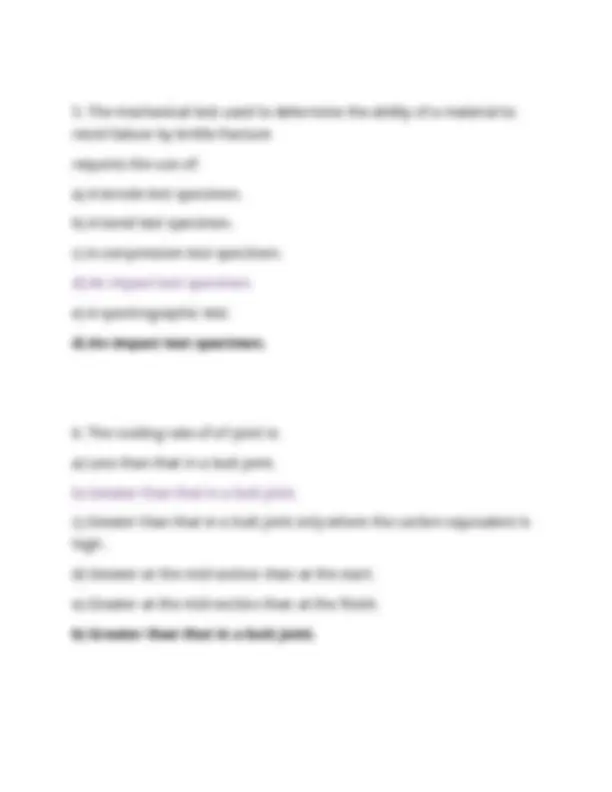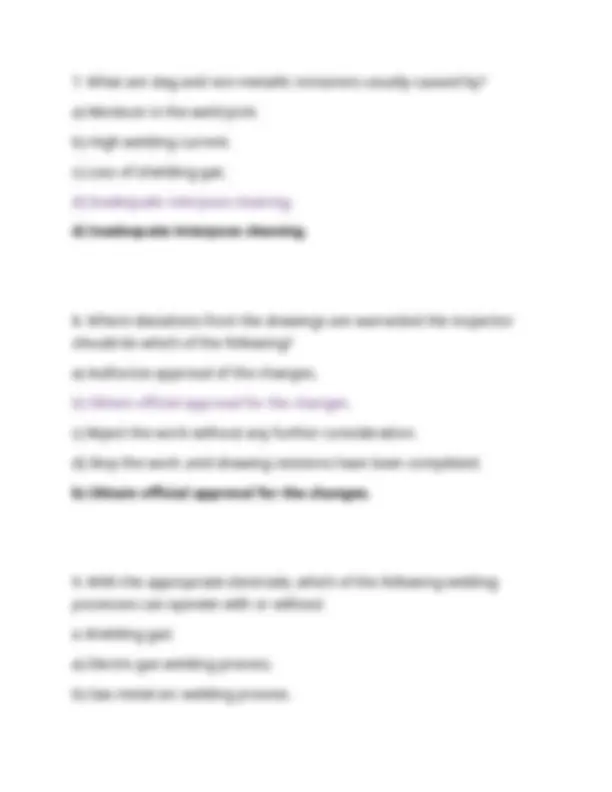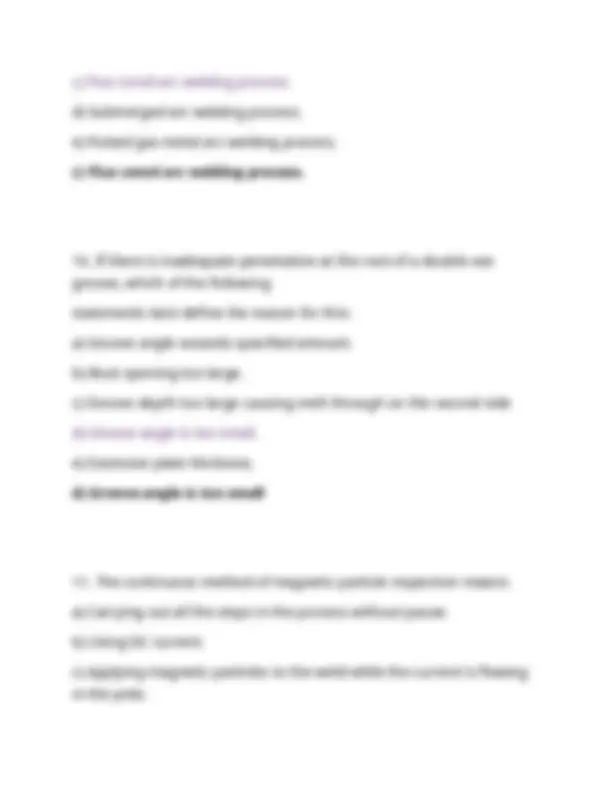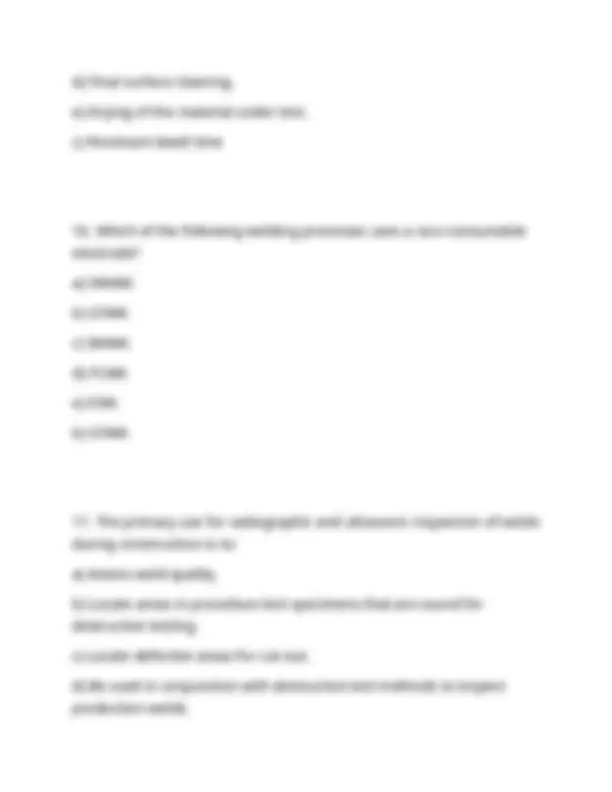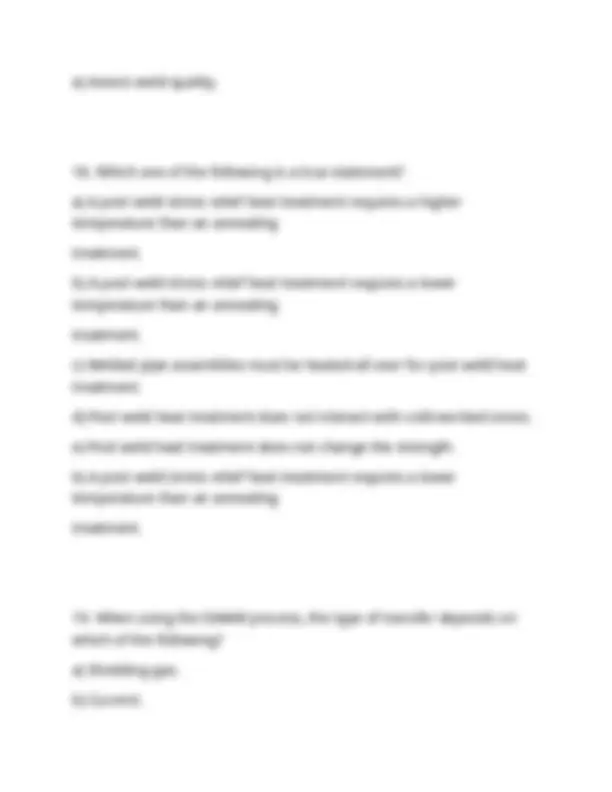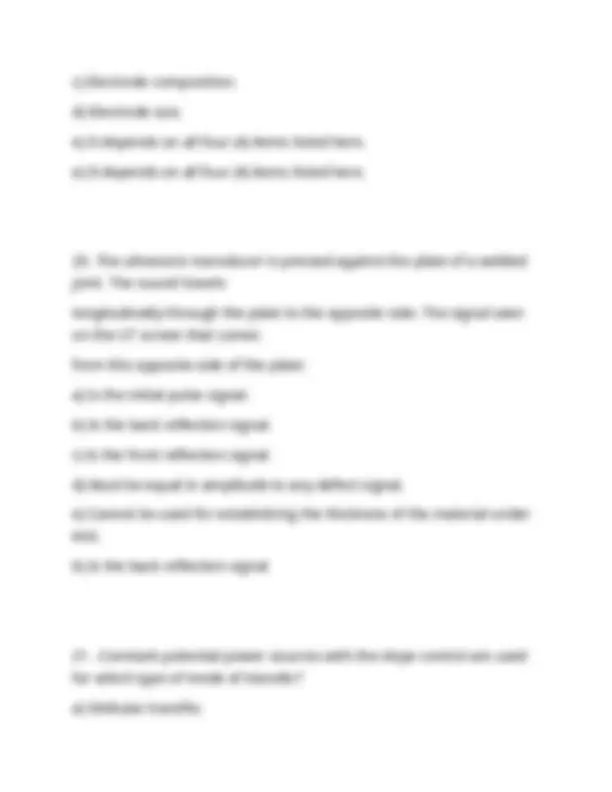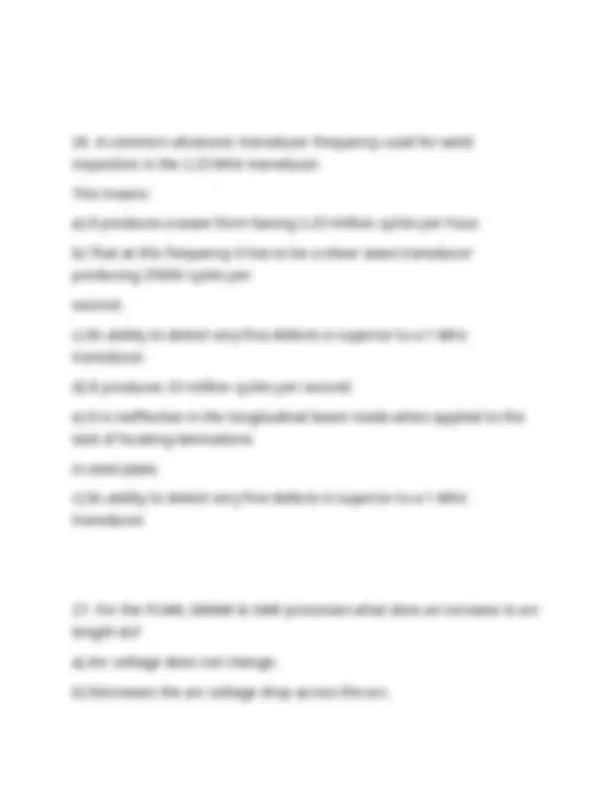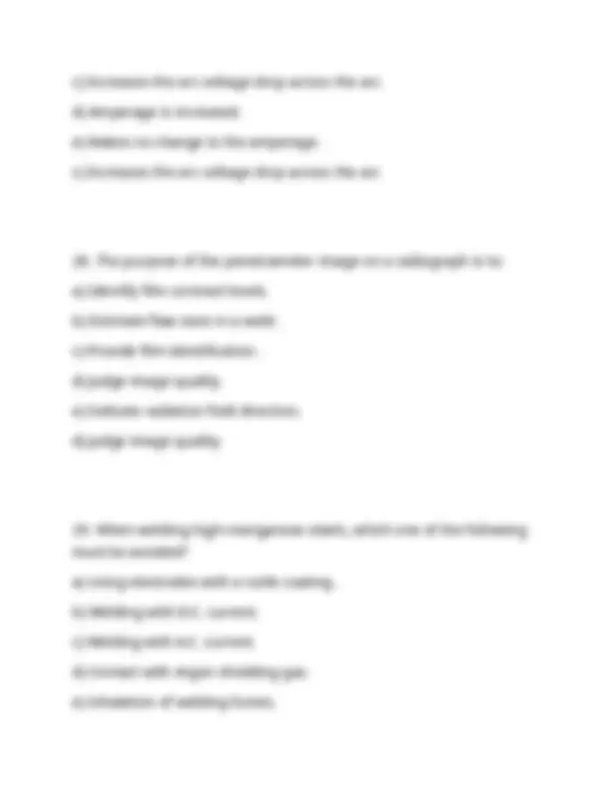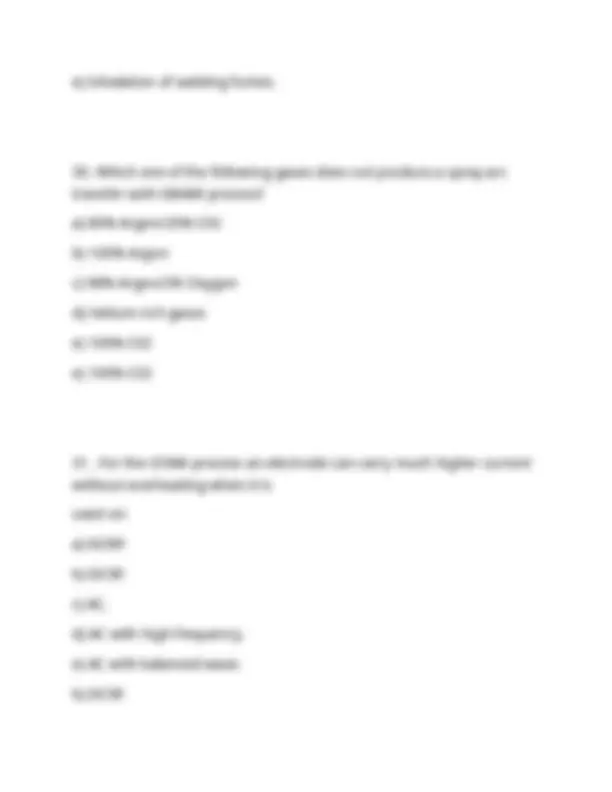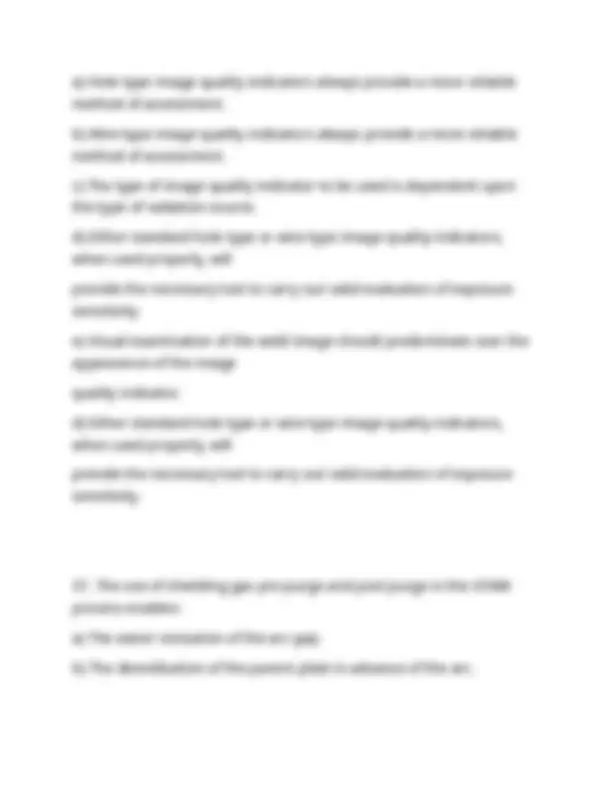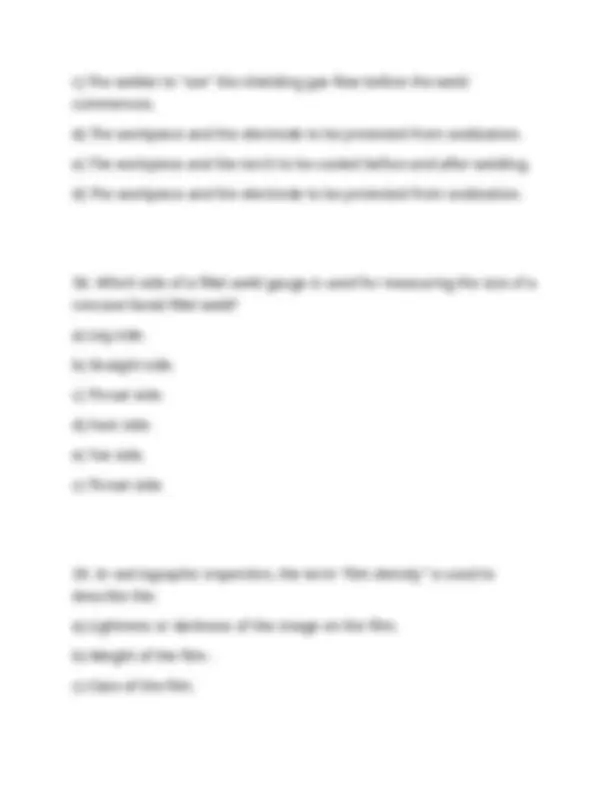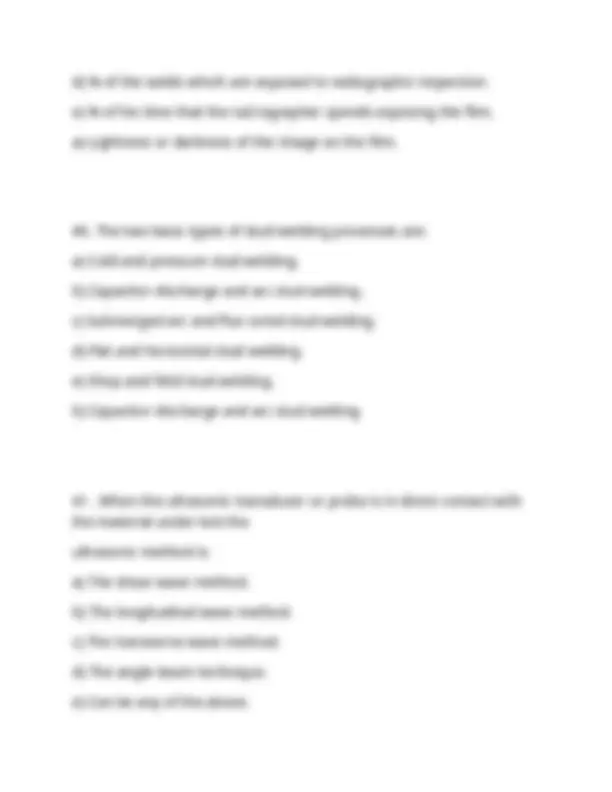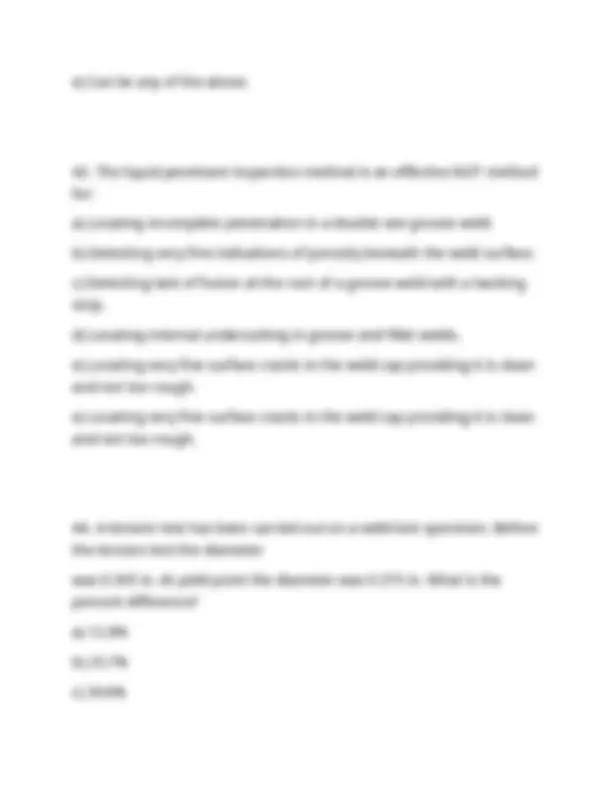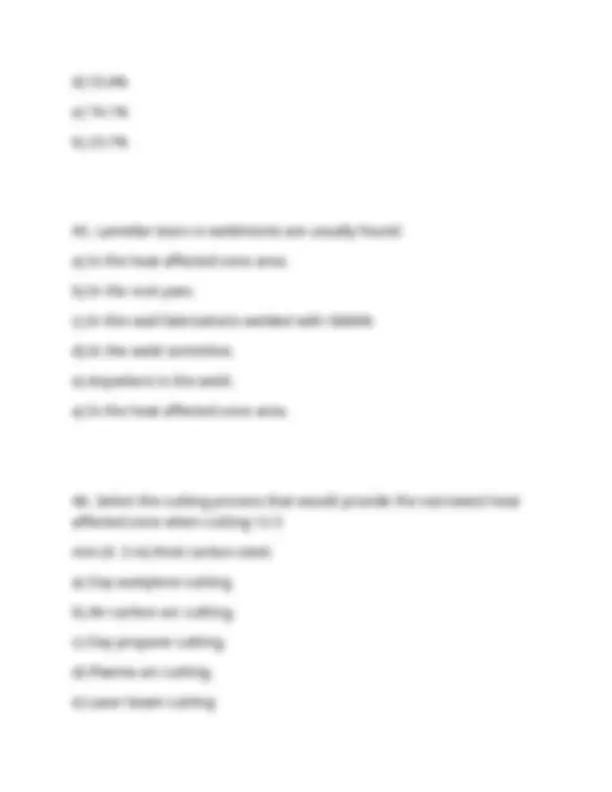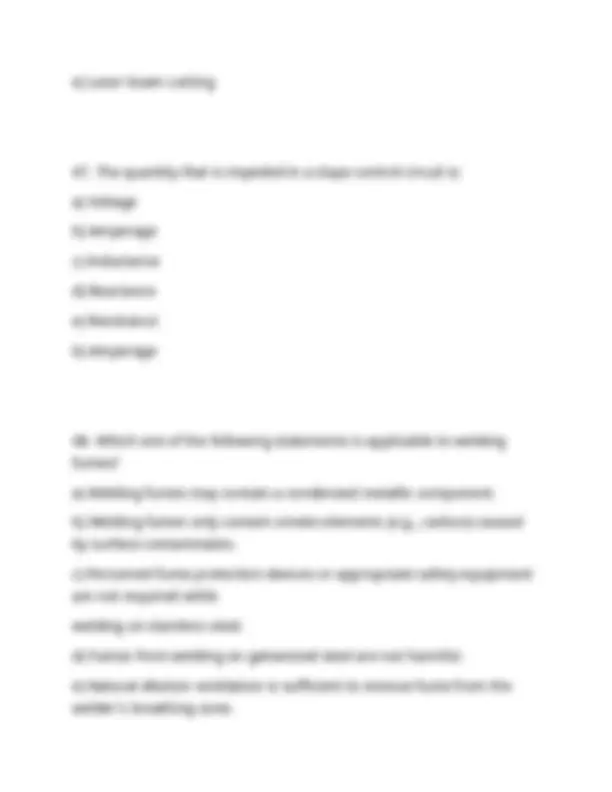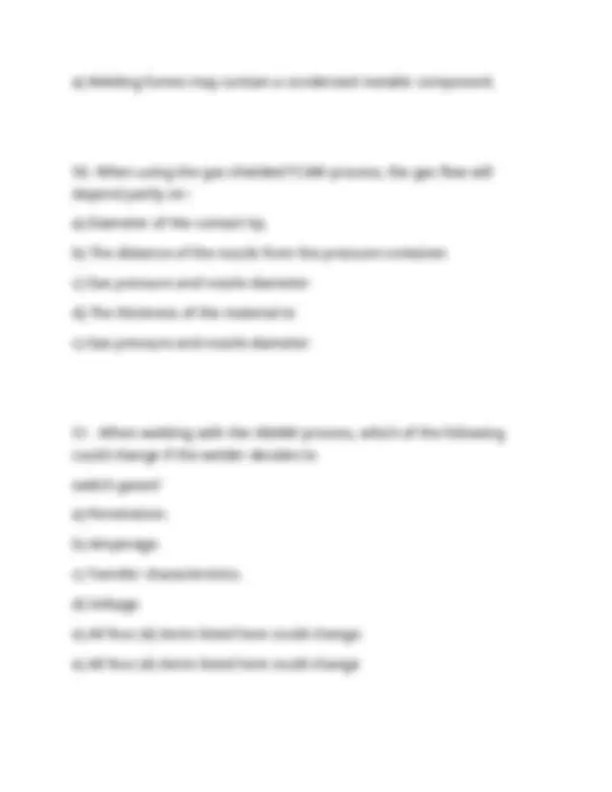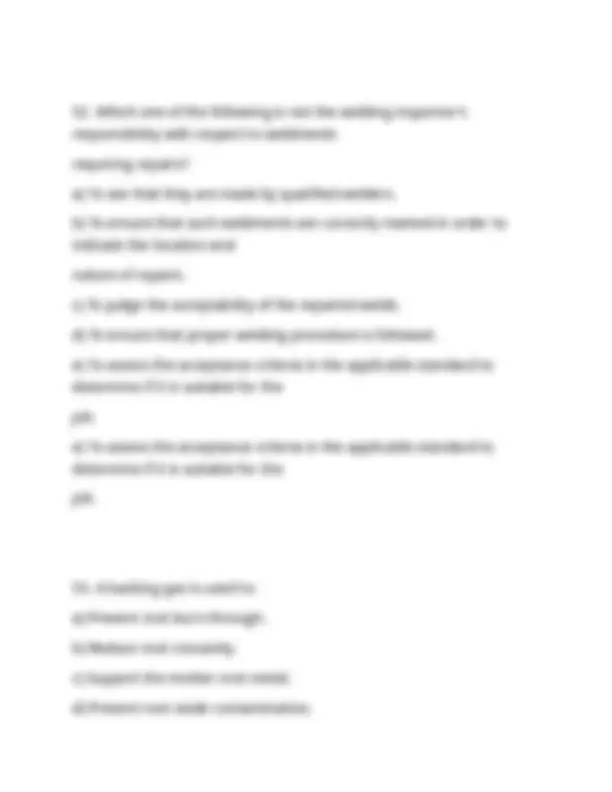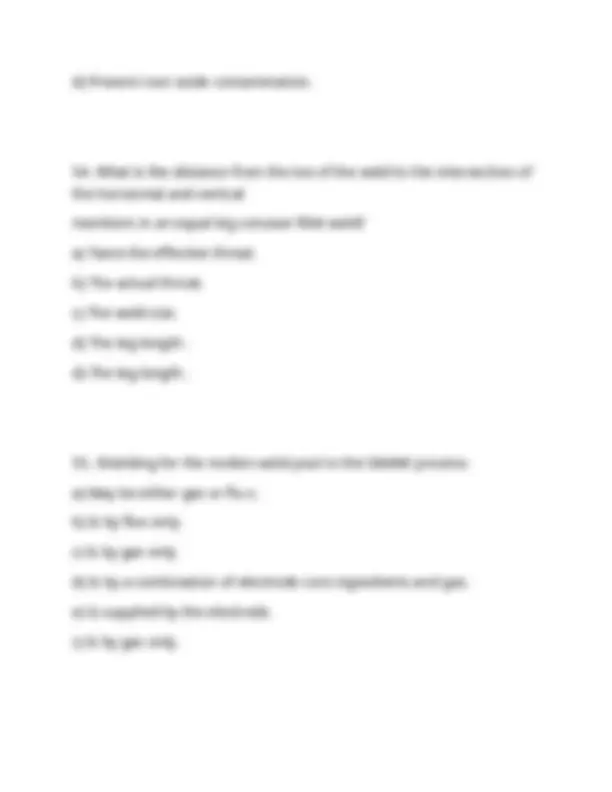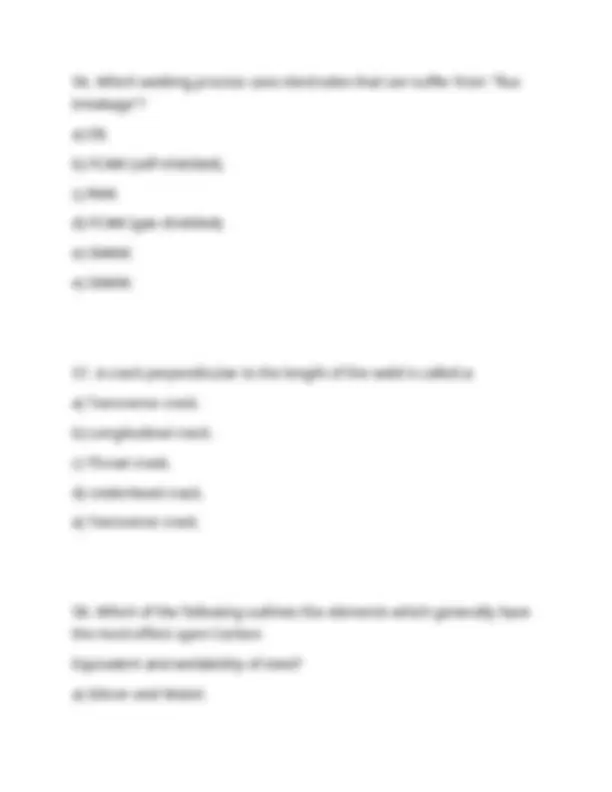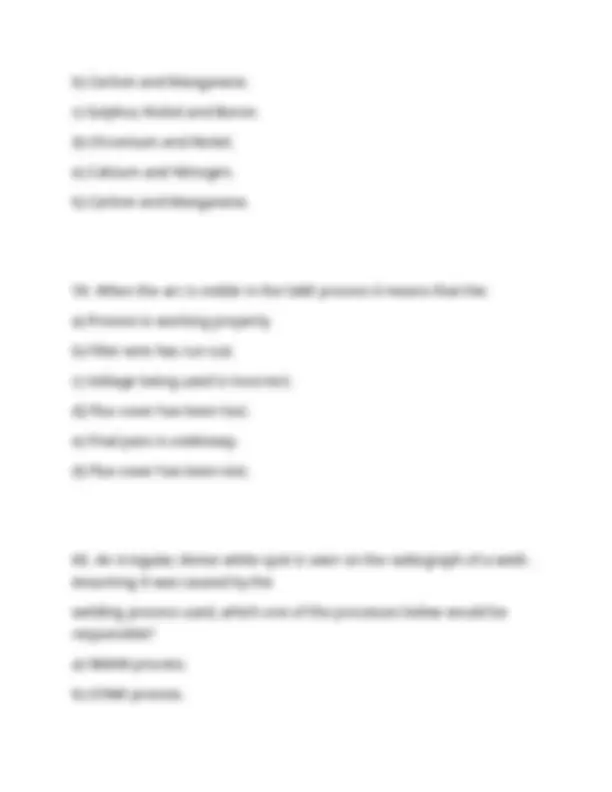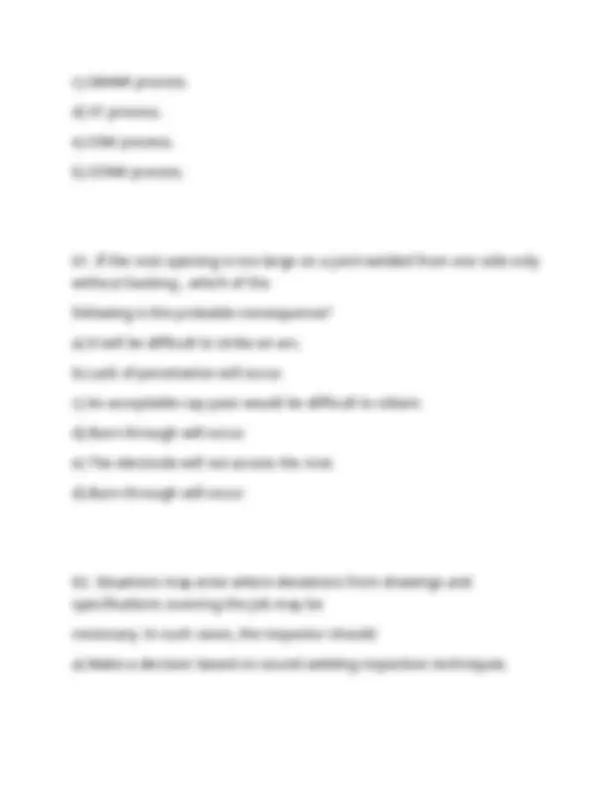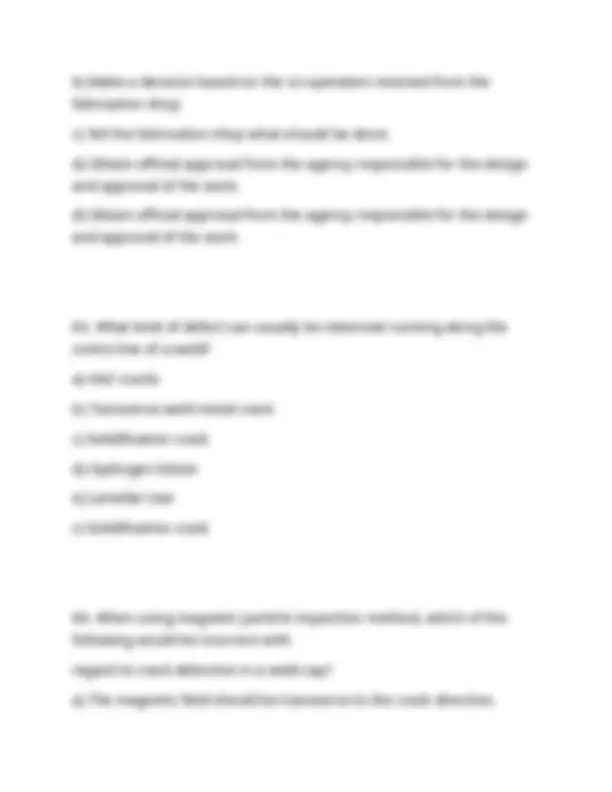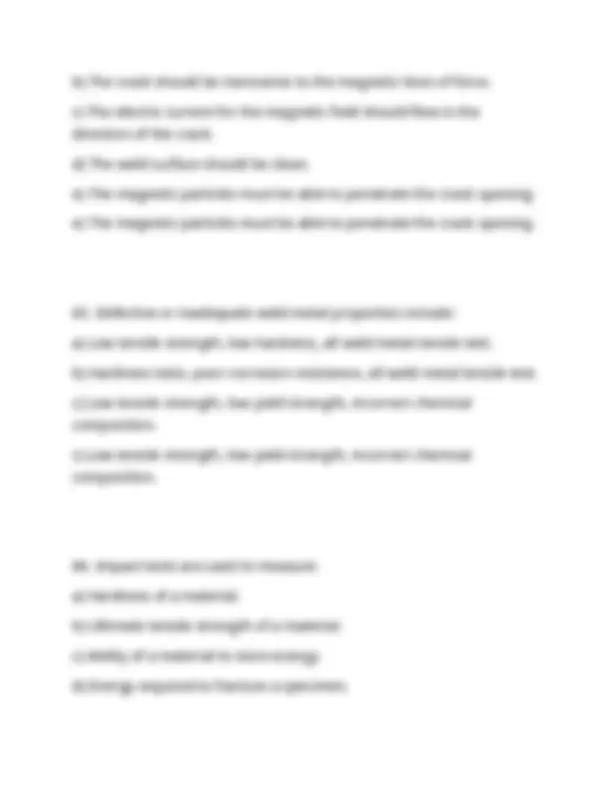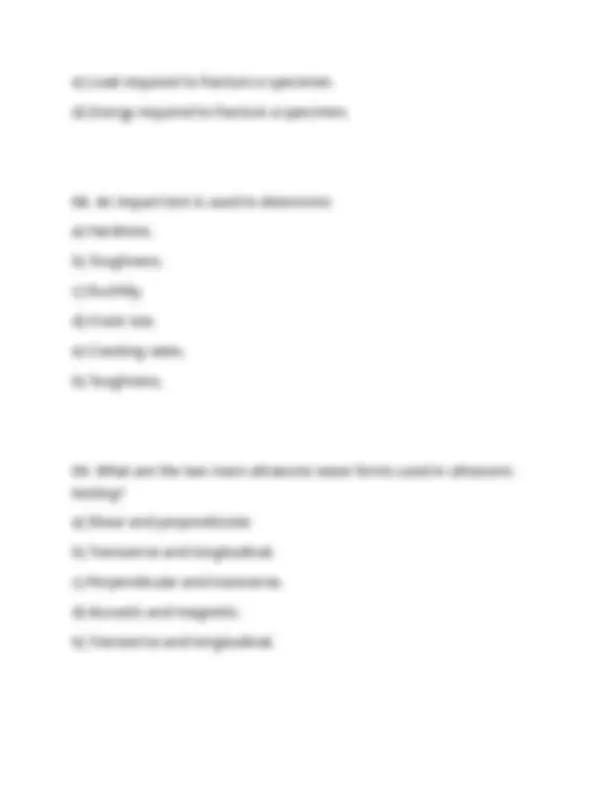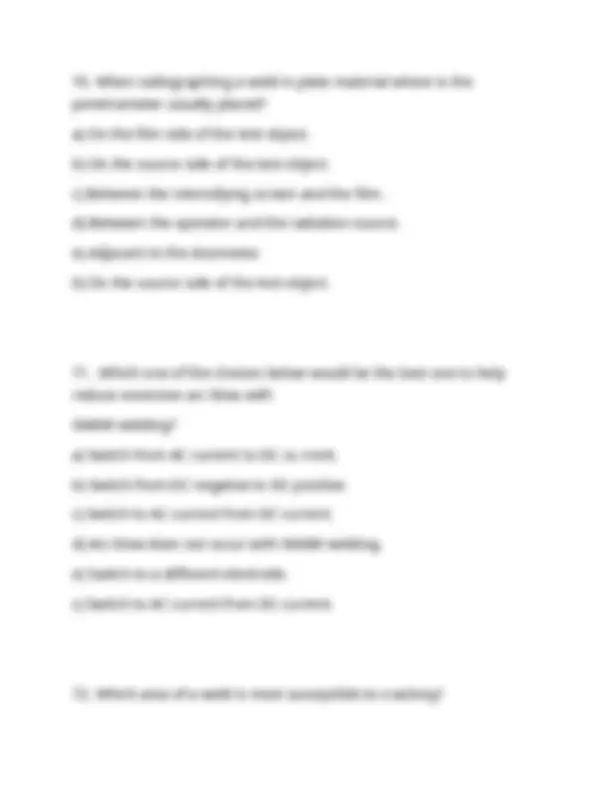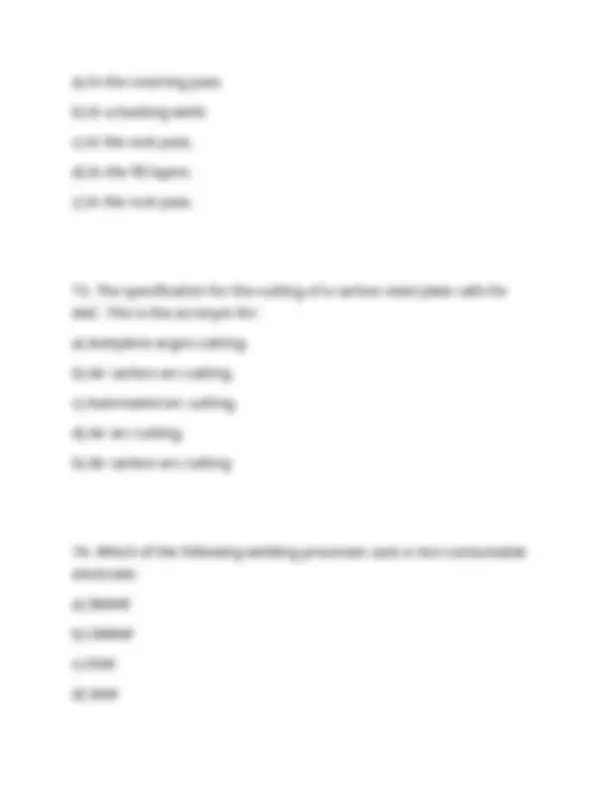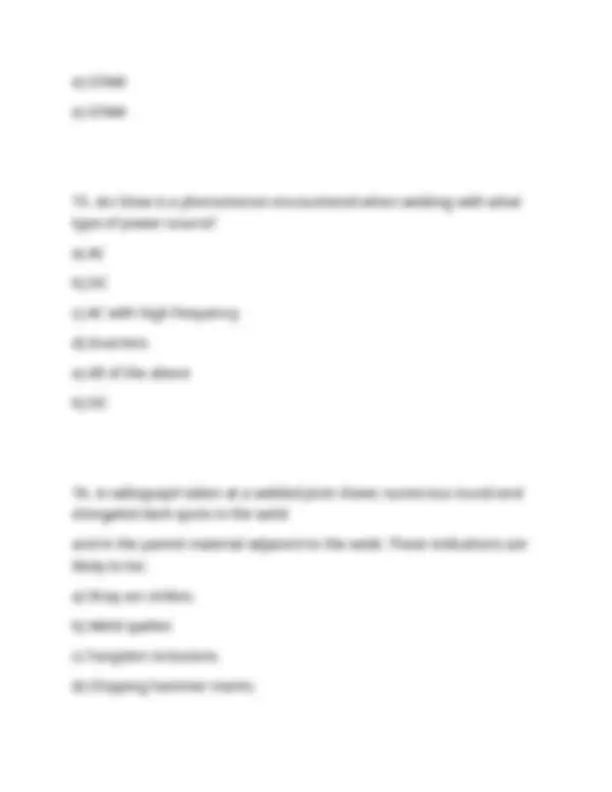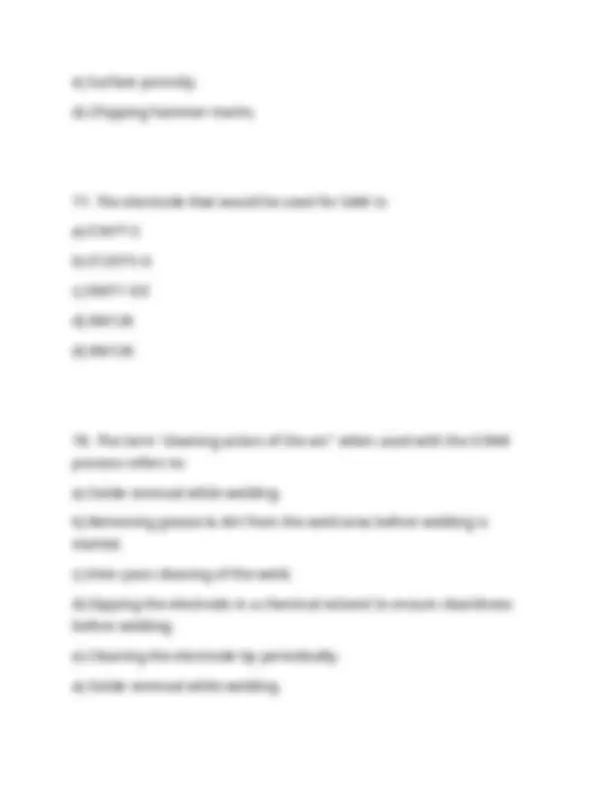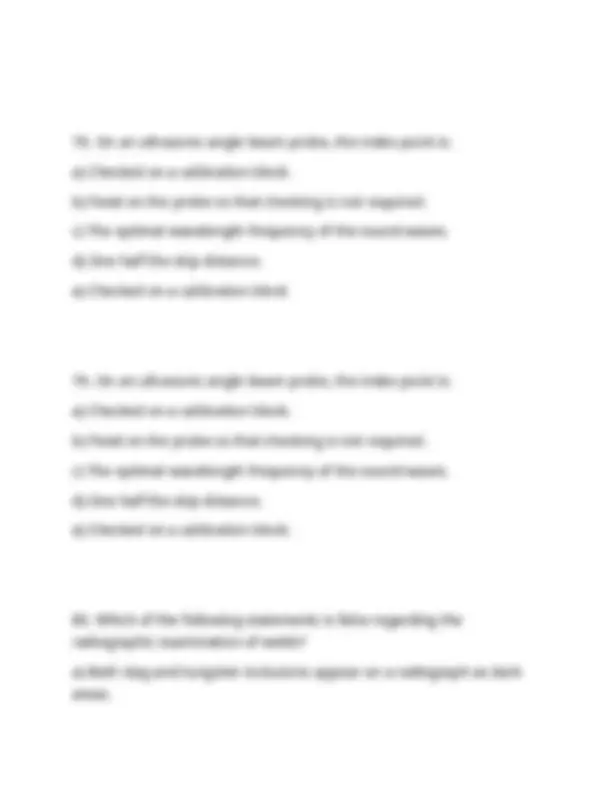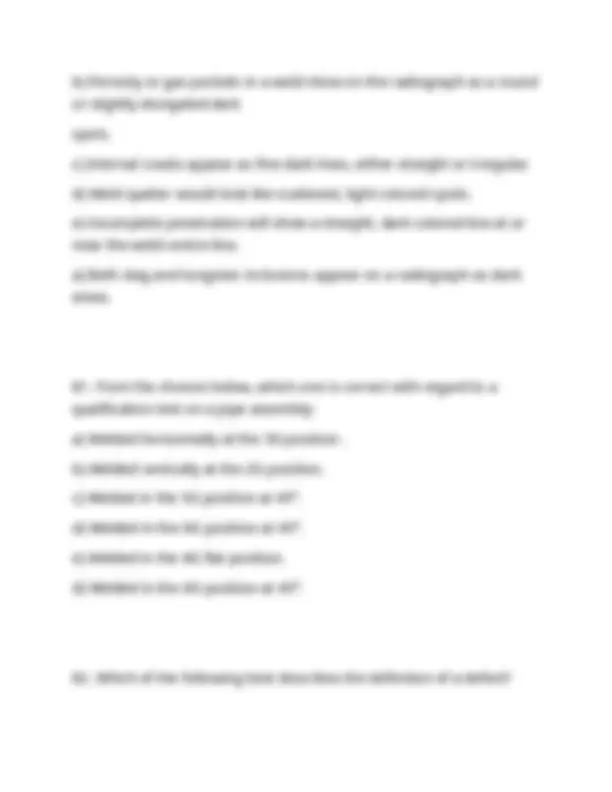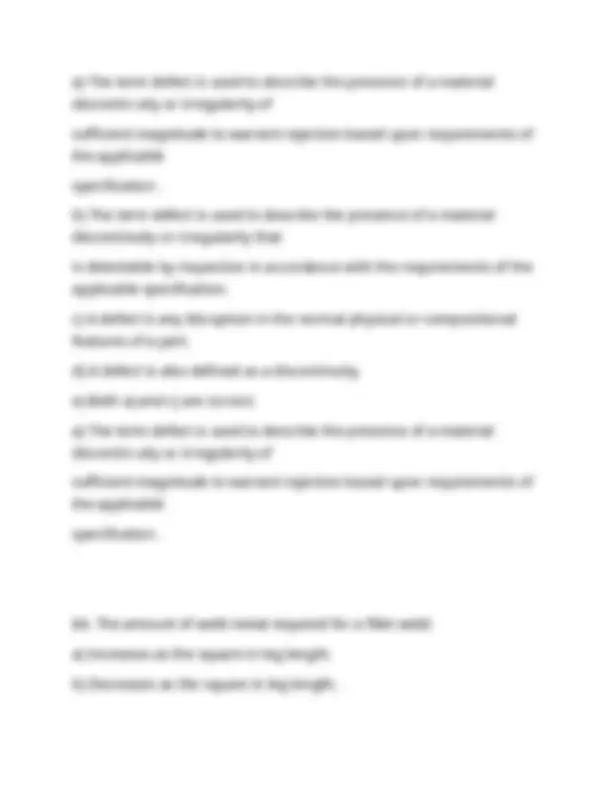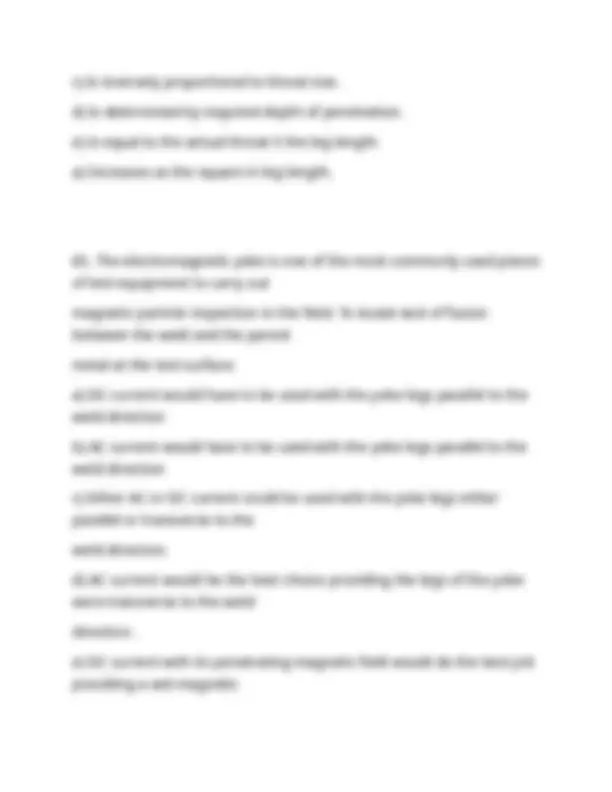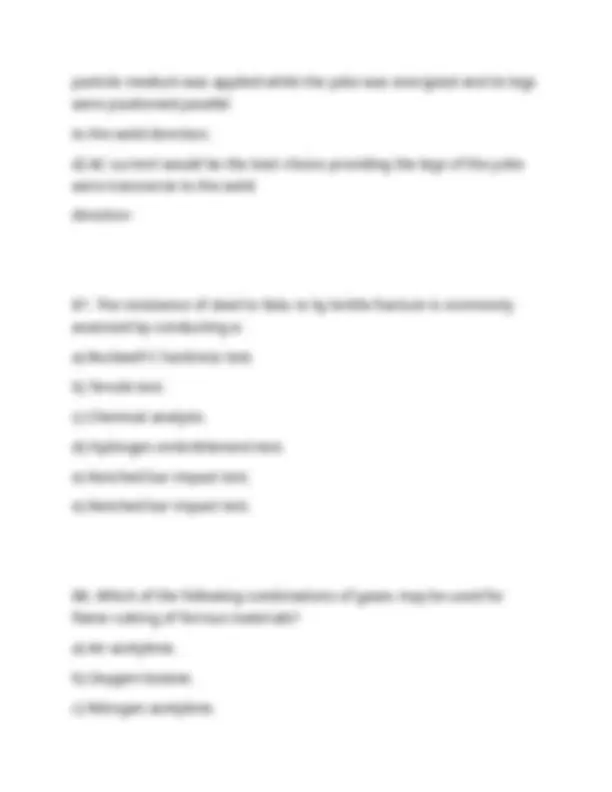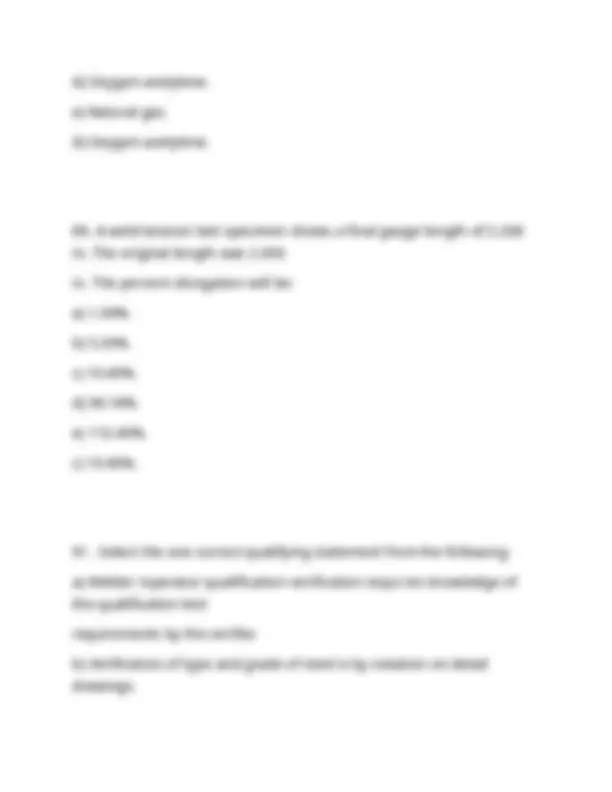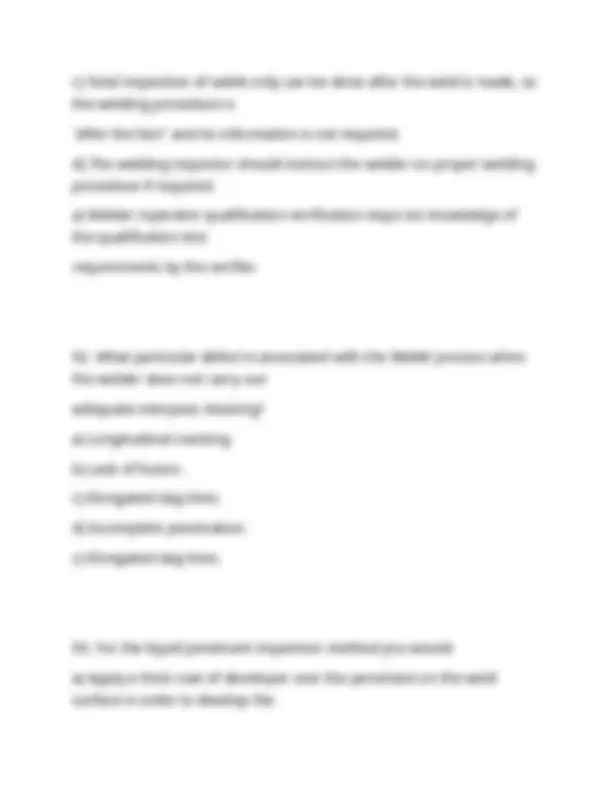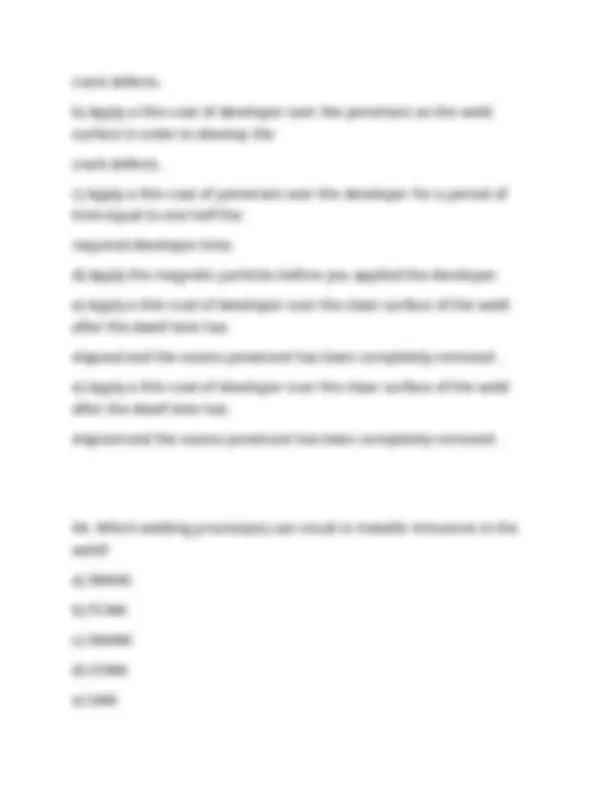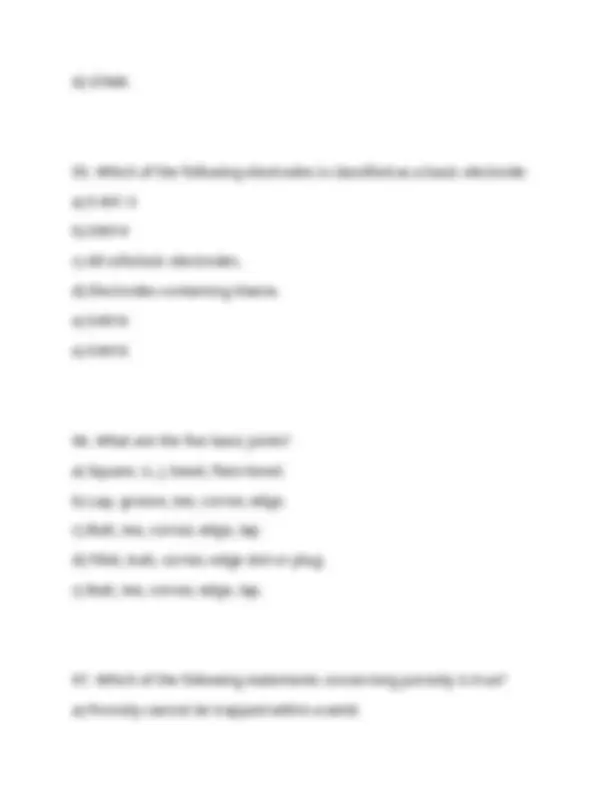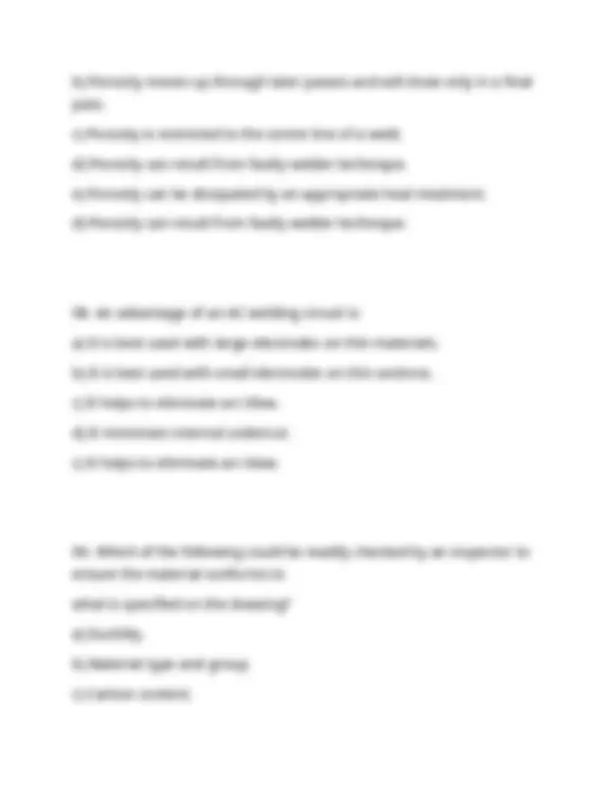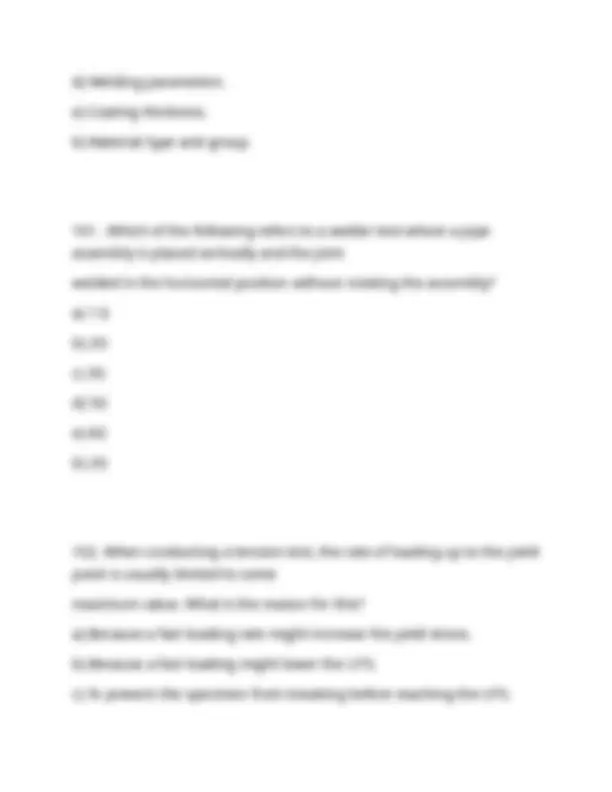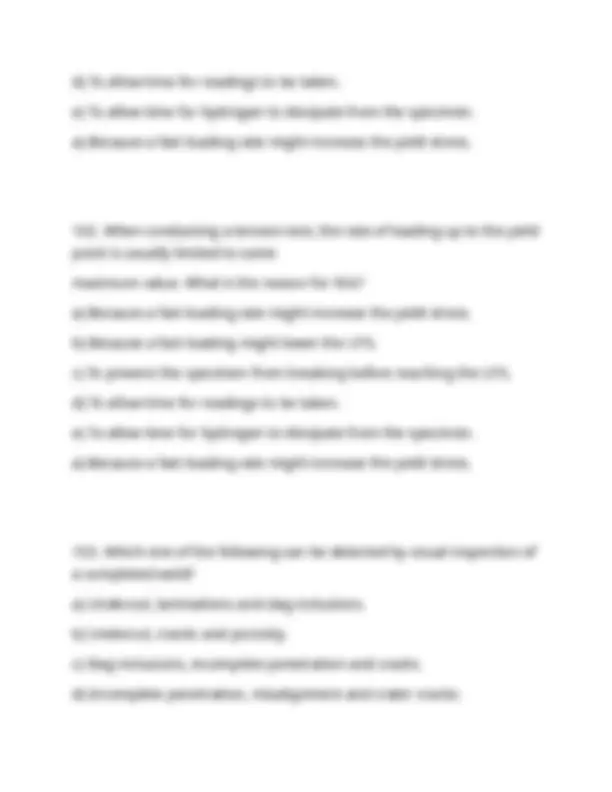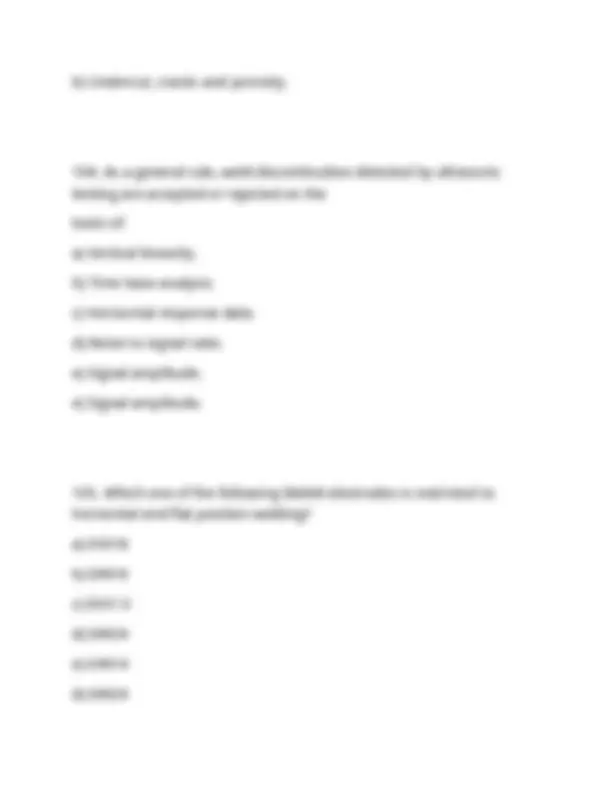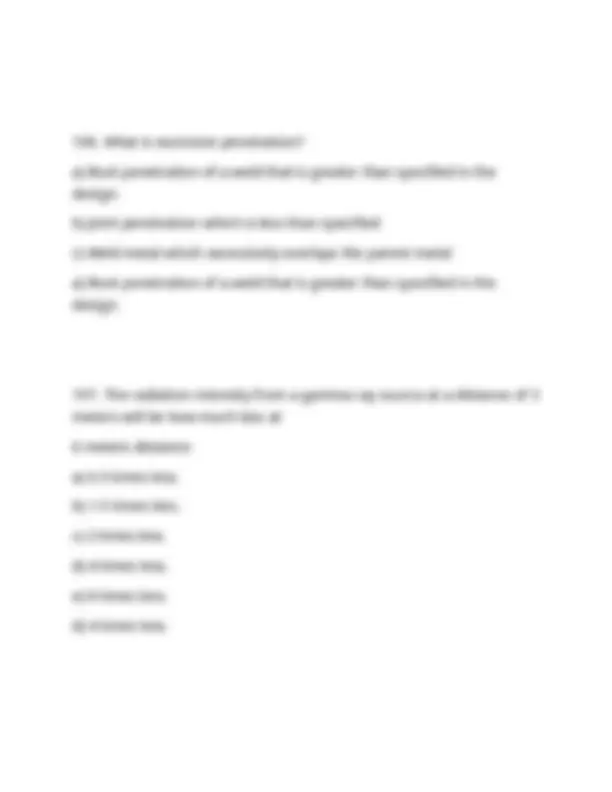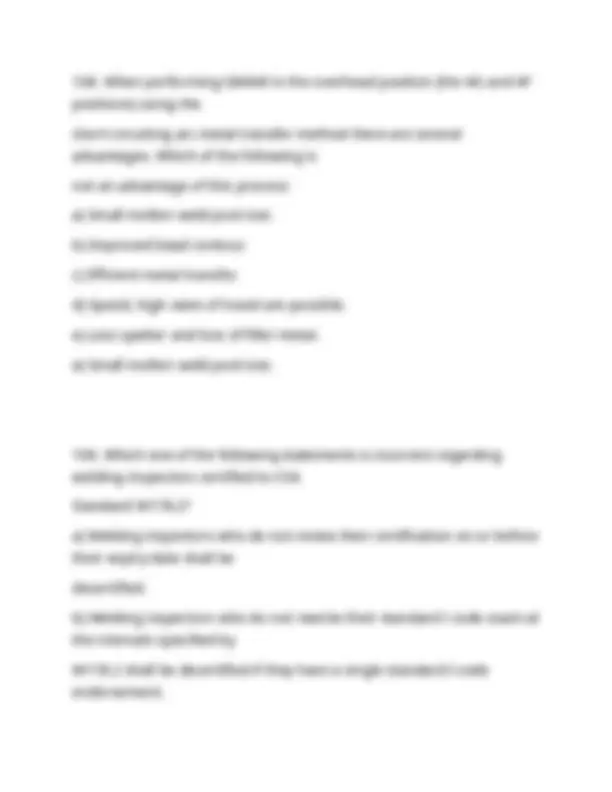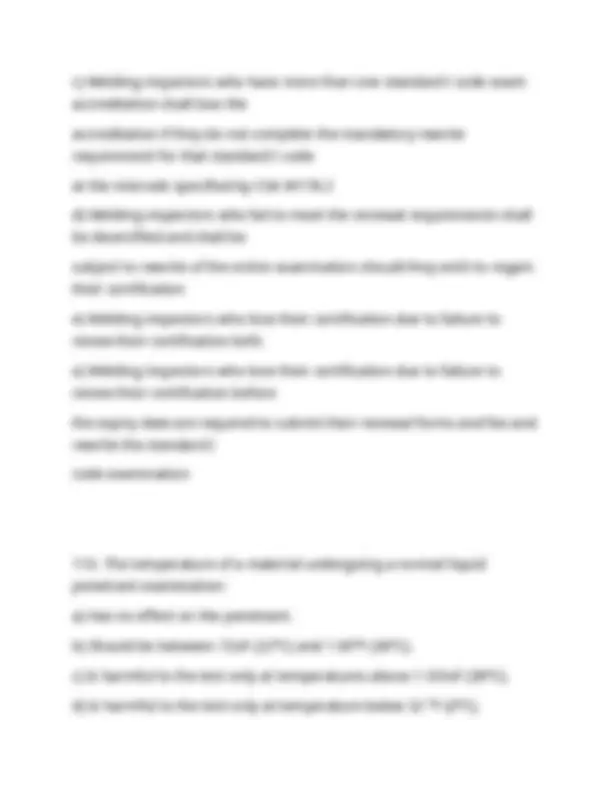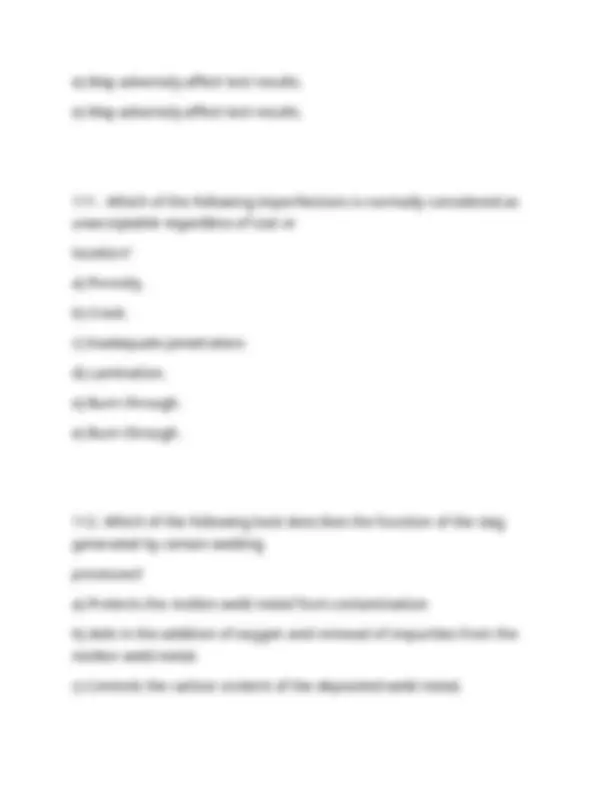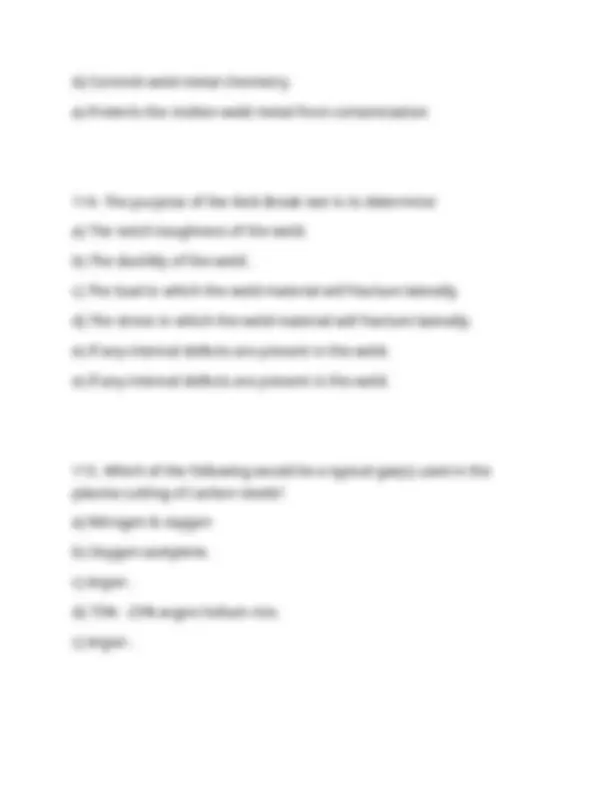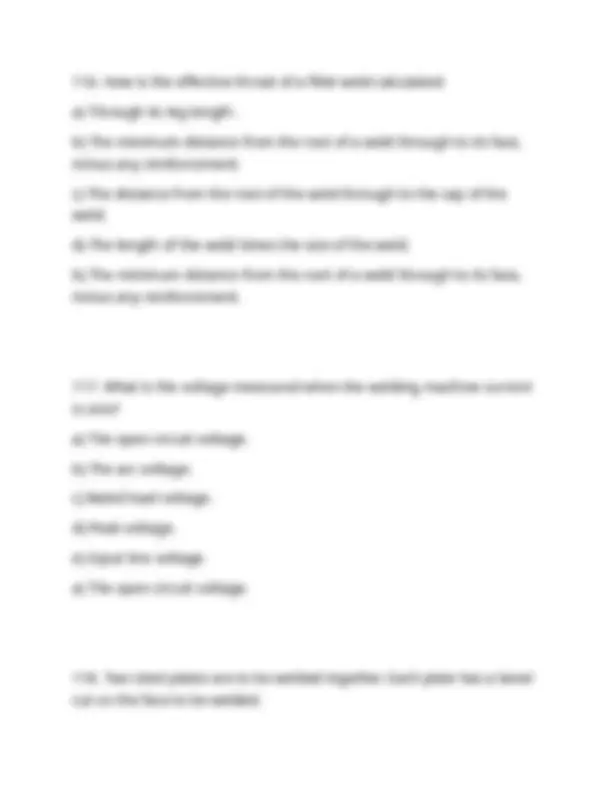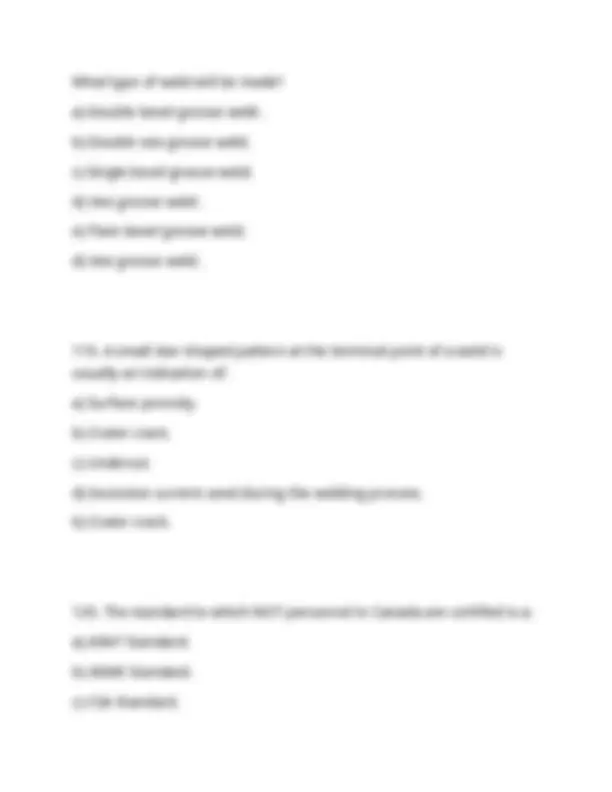Download CWB LEVEL 1 EXAM WITH COMPLETE 114 QS AND WELL ELABORATED AS|LATEST UPDATE 2025|A+ GRADED and more Exams Engineering in PDF only on Docsity!
CWB LEVEL 1 EXAM WITH COMPLETE 114 QS AND
WELL ELABORATED AS|LATEST UPDATE 2025|A+
GRADED
- Which is not a recommended method for surface cleaning of a part for liquid penetrant examination? a) Cleaning with organic solvents. b) Blasting with shot or dull sand. c) Cleaning with de-greasers. d) Use of de-scaling solutions. e) Ultrasonic cleaning methods. b) Blasting with shot or dull sand.
- Which of the following weld defects is most likely to be missed by radiography in a weld: a) Undercutting. b) Porosity. c) Slag inclusions. d) Cracking. e) Burn through. d) Cracking.
- In the choices given below, metallographic tests would be the least informative with regard to the: a) Presence of the non-metallic inclusions. b) Grain structure in the weld and fusion zone. c) Ability of the material to withstand repeated fluctuating loads. d) Extent and structure of the heat affected zone. e) Number of weld passes. c) Ability of the material to withstand repeated fluctuating loads.
- In producing a drawing for a scale of 1:50, what would be the distance represented by a distance on the drawing of 6 em? a) 12 cm. b) 30 cm. c) 50 cm. d) 240 cm. e) 300 cm. e) 300 cm.
- What are slag and non-metallic inclusions usually caused by? a) Moisture in the weld joint. b) High welding current. c) Loss of shielding gas. d) Inadequate interpose cleaning. d) Inadequate interpose cleaning.
- Where deviations from the drawings are warranted the inspector should do which of the following? a) Authorize approval of the changes. b) Obtain official approval for the changes. c) Reject the work without any further consideration. d) Stop the work until drawing revisions have been completed. b) Obtain official approval for the changes.
- With the appropriate electrode, which of the following welding processes can operate with or without a shielding gas: a) Electro gas welding process. b) Gas metal arc welding process.
c) Flux cored arc welding process. d) Submerged arc welding process. e) Pulsed gas metal arc welding process. c) Flux cored arc welding process.
- If there is inadequate penetration at the root of a double vee groove, which of the following statements best define the reason for this: a) Groove angle exceeds specified amount. b) Root opening too large. c) Groove depth too large causing melt through on the second side d) Groove angle is too small. e) Excessive plate thickness. d) Groove angle is too small
- The continuous method of magnetic particle inspection means: a) Carrying out all the steps in the process without pause. b) Using DC current. c) Applying magnetic particles to the weld while the current is flowing in the yoke.
c) Leg size of 1 0 mm. d) Face width of 10 mm. c) Leg size of 1 0 mm.
- Which welding process has an arc drawn between the workpiece and the member being welded to it? 0 a) SAW. b) CAW-G. c) PAW. d) EGW. e) SW. e) SW.
- When performing liquid penetrant examination, excess penetrant removal comes after which one of the following penetrant steps: a) Application of developer. b) Application of penetrant c) Penetrant dwell time.
d) Final surface cleaning. e) Drying of the material under test. c) Penetrant dwell time
- Which of the following welding processes uses a non-consumable electrode? a) GMAW. b) GTAW. c) SMAW. d) FCAW. e) ESW. b) GTAW.
- The primary use for radiographic and ultrasonic inspection of welds during construction is to: a) Assess weld quality. b) Locate areas in procedure test specimens that are sound for destructive testing. c) Locate defective areas for cut-out. d) Be used in conjunction with destructive test methods to inspect production welds.
c) Electrode composition. d) Electrode size. e) It depends on all four (4) items listed here. e) It depends on all four (4) items listed here.
- The ultrasonic transducer is pressed against the plate of a welded joint. The sound travels longitudinally through the plate to the opposite side. The signal seen on the UT screen that comes from this opposite side of the plate: a) Is the initial pulse signal. b) Is the back reflection signal. c) Is the front reflection signal. d) Must be equal in amplitude to any defect signal. e) Cannot be used for establishing the thickness of the material under test. b) Is the back reflection signal
- Constant potential power sources with the slope control are used for which type of mode of transfer? a) Globular transfer.
b) Spray transfer. c) Pulsed current transfer. d) Short circuit transfer. e) Axial spray transfer. d) Short circuit transfer.
- The liquid penetrant technique relies for its effectiveness upon the ability of liquid to penetrate openings to the surface due to the phenomenon of: a) Crack opening displacement. b) Material and penetrant viscosity. c) Capillary action. d) Liquid fluorescence. e) Flux leakage. c) Capillary action.
- The electrode used in flux cored arc welding is a: a) Hollow tubular wire containing an inner metal wire. b) Tubular wire containing flux or other ingredients. c) Solid wire with an oxide/flux coating.
- A common ultrasonic transducer frequency used for weld inspection is the 2.25 MHz transducer. This means: a) It produces a wave form having 2.25 million cycles per hour. b) That at this frequency it has to be a shear wave transducer producing 25000 cycles per second. c) Its ability to detect very fine defects is superior to a 1 MHz transducer. d) It produces 25 million cycles per second. e) It is ineffective in the longitudinal beam mode when applied to the task of locating laminations in steel plate. c) Its ability to detect very fine defects is superior to a 1 MHz transducer.
- For the FCAW, GMAW & SAW processes what does an increase in arc length do? a) Arc voltage does not change. b) Decreases the arc voltage drop across the arc.
c) Increases the arc voltage drop across the arc. d) Amperage is increased. e) Makes no change to the amperage. c) Increases the arc voltage drop across the arc
- The purpose of the penetrameter image on a radiograph is to: a) Identify film contrast levels. b) Estimate flaw sizes in a weld. c) Provide film identification. d) Judge image quality. e) Indicate radiation field direction. d) Judge image quality.
- When welding high-manganese steels, which one of the following must be avoided? a) Using electrodes with a rutile coating. b) Welding with D.C. current. c) Welding with A.C. current. d) Contact with Argon shielding gas. e) Inhalation of welding fumes.
- Which electrode would be used for all position welding, when severe impact requirements must be met? a) E b) E c) E6218-BL d) E4918- e) E d) E4918-
- Select the correct penetrameter thickness for 2% sensitivity when radiographing a weldment 1. inches in thickness. a) 0.012 in. b) 0.015 in. c) 0.025 in. d) 0.030 in. c) 0.025 in.
- A guided root bend test on a weld test specimen would show: a) The weld ductility by measuring the difference in distance between gauge marks. b) Excessive reinforcement. c) The integrity of the face-weld. d) Lack of penetration or fusion. e) HAZ properties. d) Lack of penetration or fusion.
- Acetylene cannot be used safely at pressures greater than: a) 103 Kpa (15 psi). b) 172 Kpa (25 psi). c) 310 Kpa (45 psi). d) 552 Kpa (80 psi). e) 15167 KPa (2200 psi). a) 103 Kpa (15 psi).
- When assessing radiographic image sensitivity during weld inspection:
c) The welder to "see" the shielding gas flow before the weld commences. d) The workpiece and the electrode to be protected from oxidization. e) The workpiece and the torch to be cooled before and after welding. d) The workpiece and the electrode to be protected from oxidization.
- Which side of a fillet weld gauge is used for measuring the size of a concave faced fillet weld? a) Leg side. b) Straight side. c) Throat side. d) Face side. e) Toe side. c) Throat side.
- In rad iographic inspection, the term "film density" is used to describe the: a) Lightness or darkness of the image on the film. b) Weight of the film. c) Class of the film.
d) % of the welds which are exposed to radiographic inspection. e) % of his time that the rad iographer spends exposing the film. a) Lightness or darkness of the image on the film.
- The two basic types of stud welding processes are: a) Cold and pressure stud welding. b) Capacitor discharge and arc stud welding. c) Submerged arc and flux cored stud welding. d) Flat and horizontal stud welding. e) Shop and field stud welding. b) Capacitor discharge and arc stud welding
- When the ultrasonic transducer or probe is in direct contact with the material under test the ultrasonic method is: a) The shear wave method. b) The longitudinal wave method. c) The transverse wave method. d) The angle beam technique. e) Can be any of the above.

